Exercise: Photomontage
BRIEF
Make a montage or collage with a political message. The subject matter could be a current issue, or something you feel strongly about such as animal rights, the treatment of elderly people or images of women in the media.
Collect images from newspapers, magazines, your own photographs or images online (check for copyright). Create new messages out of these extant images by juxtaposing and contrasting them. Be imaginative, playful, provocative or humorous.
Reflect on the original meaning of the images and subsequent collage. Write a short evaluative statement.
RESEARCH
According to the Tate website, montage can be defined as an assembly of images that relate to each other in some way to create a single work or part of a work of art. Photomontages were first used by the Dadaist artists to protest against the First World War and responding to modernity in general. Images were taken from various sources and combined to create a message different to the individual elements’ intended meanings. Although these works were often humorous, the underlying connotations were revealing and critical of the subject matter. The Surrealists went on to employ the technique using it as a tool to explore dreams and the inner mind. Photomontage became a major tool in advertising (including propaganda) and graphic design. Photomontage is still used by present day artists/designers, for example, creating the covers of music albums.
I started this exercise by creating a Pinterest board with some examples so that I could become familiar with the technique: Photomontages Pinterest board.
Particular images that stood out to me were these ones:
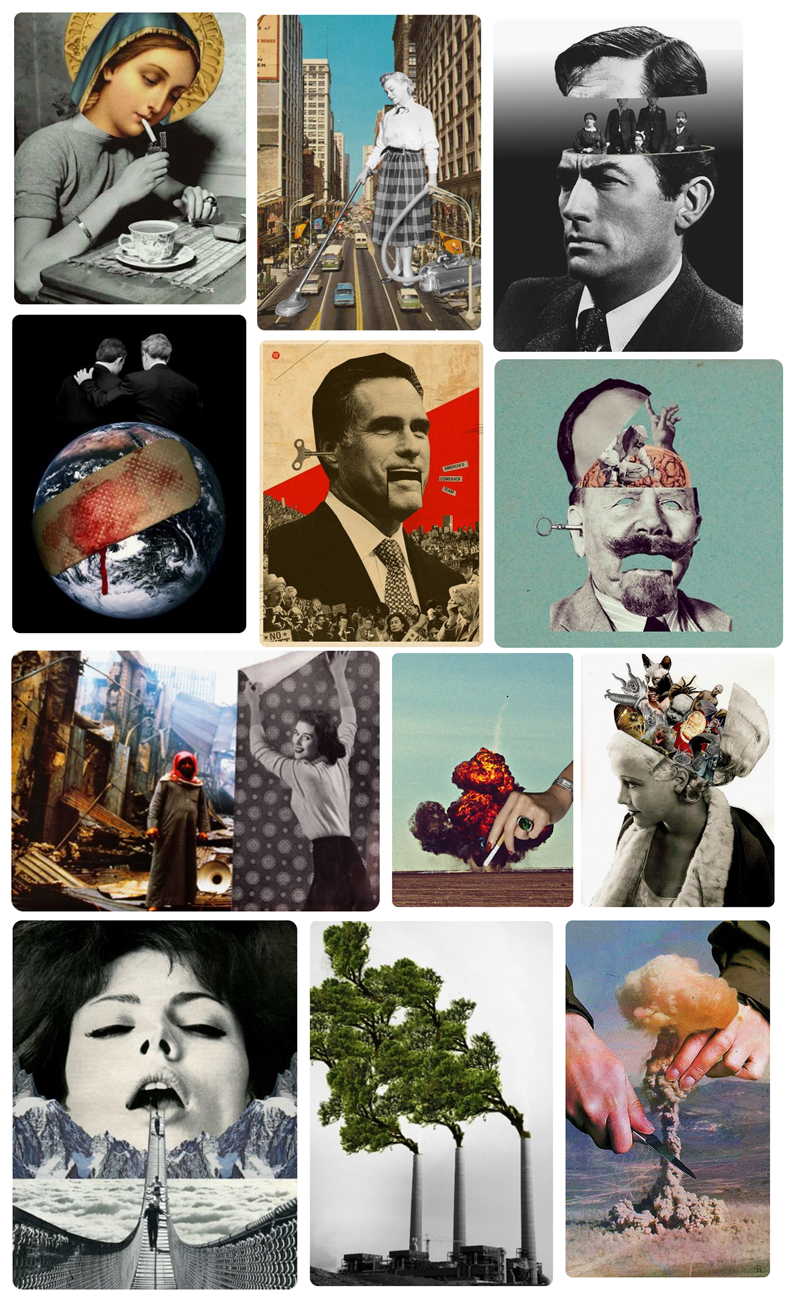
From this selection, I could see some common trends that appealed to me:
- Cutting the top of people’s heads off (!) and filling this space with other visual elements. In addition, making a person look like a wind-up/ventriloquist doll by the addition of a wind-up key in their ear and separating the lower jaw from the rest of the face.
- The use of scale – e.g. adding extremely enlarged human hands and heads to environmental scenes.
- The combination of greyscale and colour images, which creates a contrast that makes the colour elements stand out.
- A clear visual message that could be interpreted without explanation, for example the plaster on planet Earth, the trees replacing smoke coming out of factory chimneys and the hands cutting the bomb blast as one might cut a flower. The montage of the smiling lady wall-papering over the devastating scene of a war in the background is particularly strong.
- The use of contrast between the original images creates a powerful message.
Next, I researched specific artists who have used photomontage (and/or collage) in their work:
Eileen Agar
Herbert Bayer
Lou Beach
Marianne Brandt
Albertas Broga
Lester Beall
Claude Cahun (Lucy Schwob)
Michael Carney
Joseph Cornell
Peter Dunn
Michael Engelmann
Beatrix Farkas
Guerilla Girls
Richard Hamilton
Raoul Hausmann
John Heartfield
Hannah Hoch
Julian House
Peter Kennard
Mike King
Herbert Leupin
Loraine Leeson
Linder (Linda Sterling)
El Lissitzky
Gary Lomax
Herbert Matter
Laszlo Moholy-Nagy
Agnes Montgomery
Francis Picabia
Robert Pollard
Paula do Prado
Man Ray
Jamie Reid
Aleksander Rodchenko
Martha Rosler
M&C Saatchi
Annegret Saltau
Kurt Schwitters
Nancy Spero
Ken Sprague
Klaus Staeck
Vladimir and Georgii Stenberg (The Stenberg Brothers)
John Stezaker
Jesse Treece
Kara Walker
Joe Webb
After reading about each of the above artists and viewing examples of their work (see links in Resources), I selected those I would most like to influence mine for this exercise.
Herbert Bayer
I was particularly drawn to the humour in this photomontage by Herbert Bayer. The artist was part of both the Dadaist and Surrealist movements, which explains the combination of humour and dream-like quality of this piece. The expression on the artist’s face implies horror at the fact the sponge he has in his hand has transformed into a chunk of his opposite arm that has been removed. The image was meant to question the seriousness of traditional self-portraits.
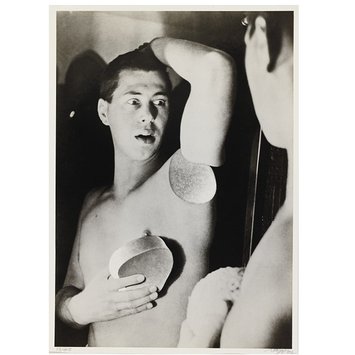
Marianne Brandt
One of the subjects that really interested me whilst carrying out research for this exercise was how artists approached the subject of women and gender equality. In this photomontage, Brandt was referring to the relationship between the two genders at the Bauhaus School, a modern-day women controlled like a puppet by a conservatively dressed , older male. I found it to be quite powerful as even if the viewer is unaware of the specific context of the meaning, it nevertheless can be universally interpreted and is still relevant today.
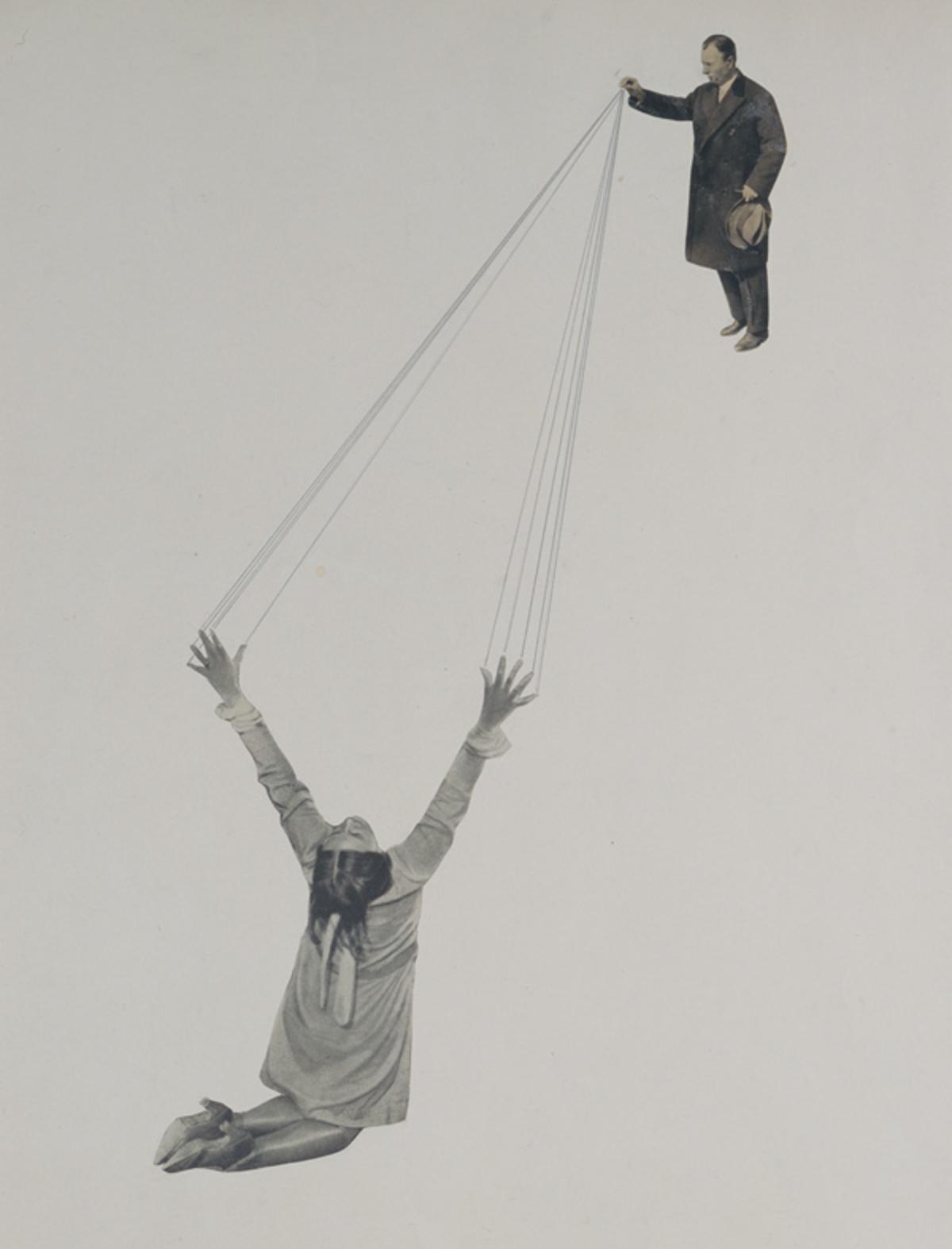
Guerrilla Girls
This is another image that relates to the issue of women and gender, questioning the representation of female artists in art galleries. I thought the text and the image reinforced one another well. The trademark gorilla mark adds a sense of humour to a serious subject. As a side note I noticed the colour palette used was complementary – yellow and purple.
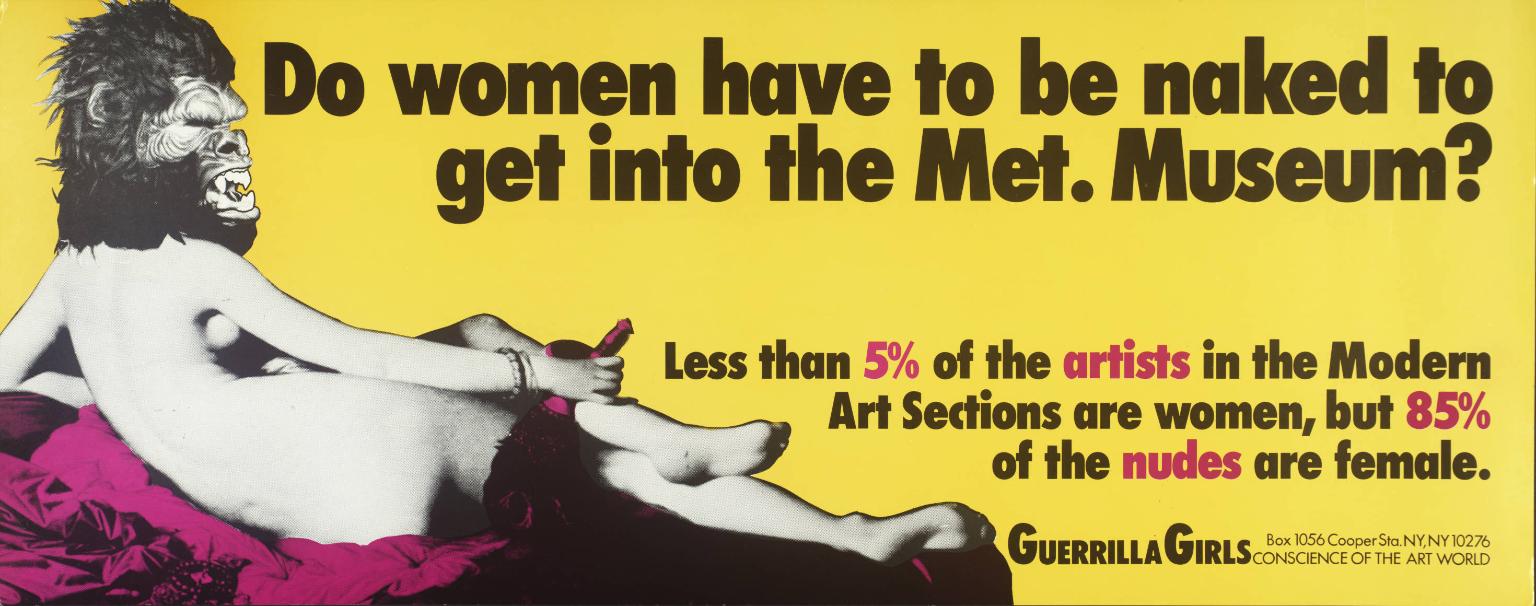
John Heartfield was one of the original photomontage artists. I found the balance between humour and underlying seriousness of his work to be very inspirational. The bulk of Heartfield’s work was against the Nazi regime and, as a result, he risked his life for his art. This particular image refers to both the process of creating a photomontage, i.e. cutting out images, and highlights the police brutality imposed by the Commissioner at that time.
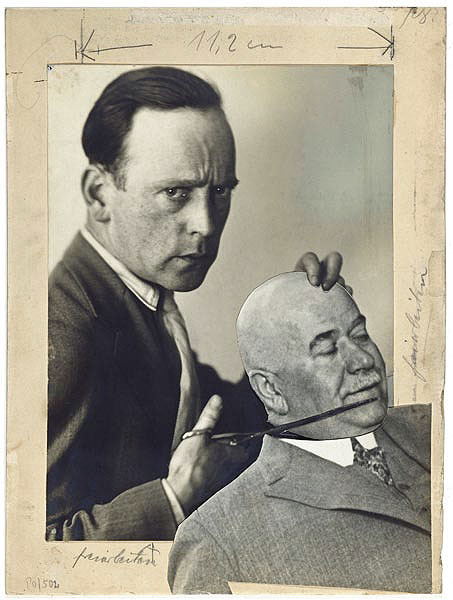
Peter Kennard
There were a great deal of photomontages by Peter Kennard to choose from, with strong political messages but I felt this one stood out to me as it takes such an well-known painting of an idyllic, ‘perfect’ English countryside landscape and juxtaposed it with nuclear warheads. The message this contrast creates is very strong and, notably, it does not have an obvious humorous tone to it as with many of the other montages.
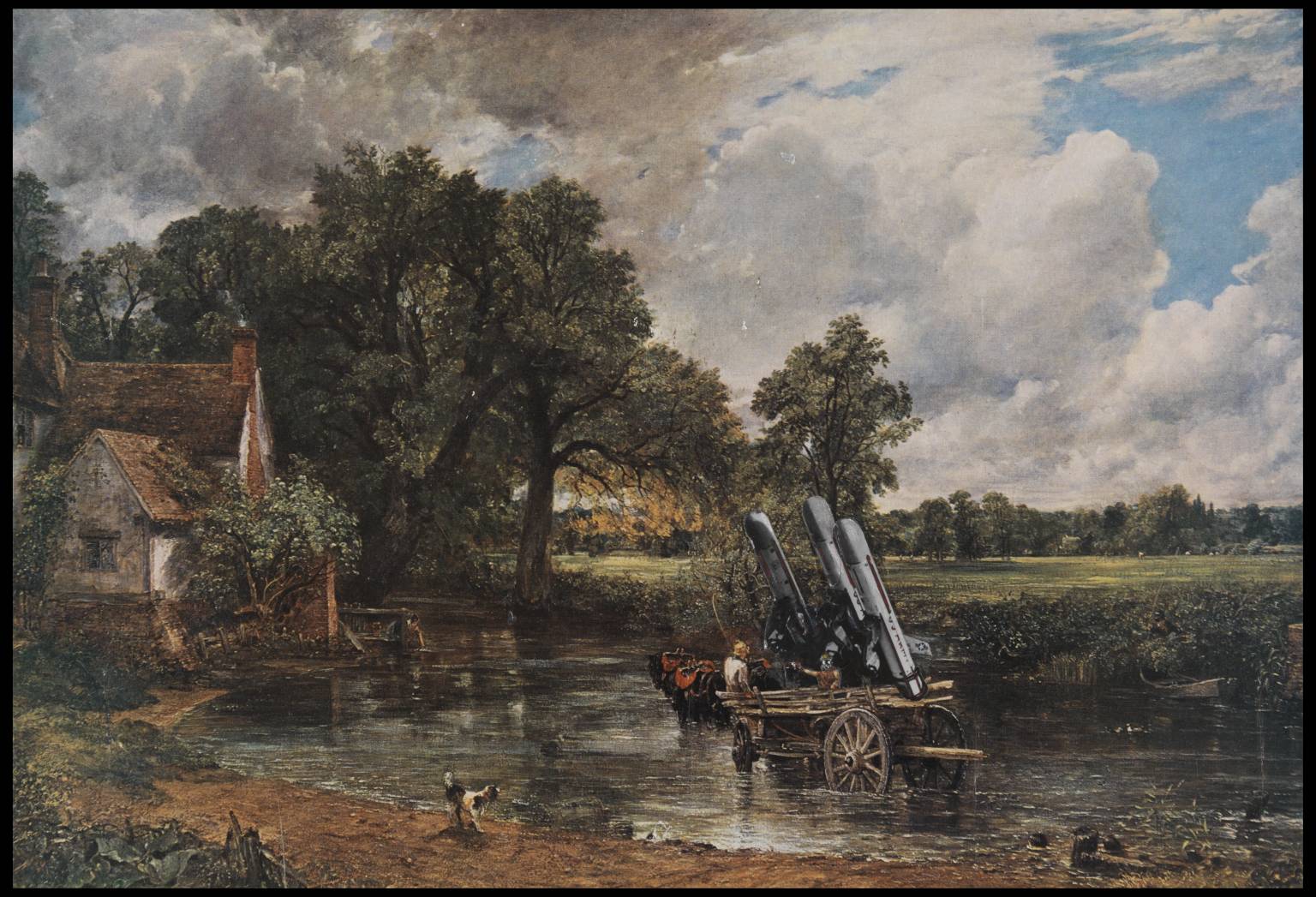
I thought that this image by Linder was very powerful at commenting on the issue of the role of women in the home and in society as a whole. The artist used a typical photograph from a magazine at that time and added quite a violent and shocking element of the woman stabbing herself in the eyes with an enlarged dinner fork. I felt the image still holds importance in the present day.
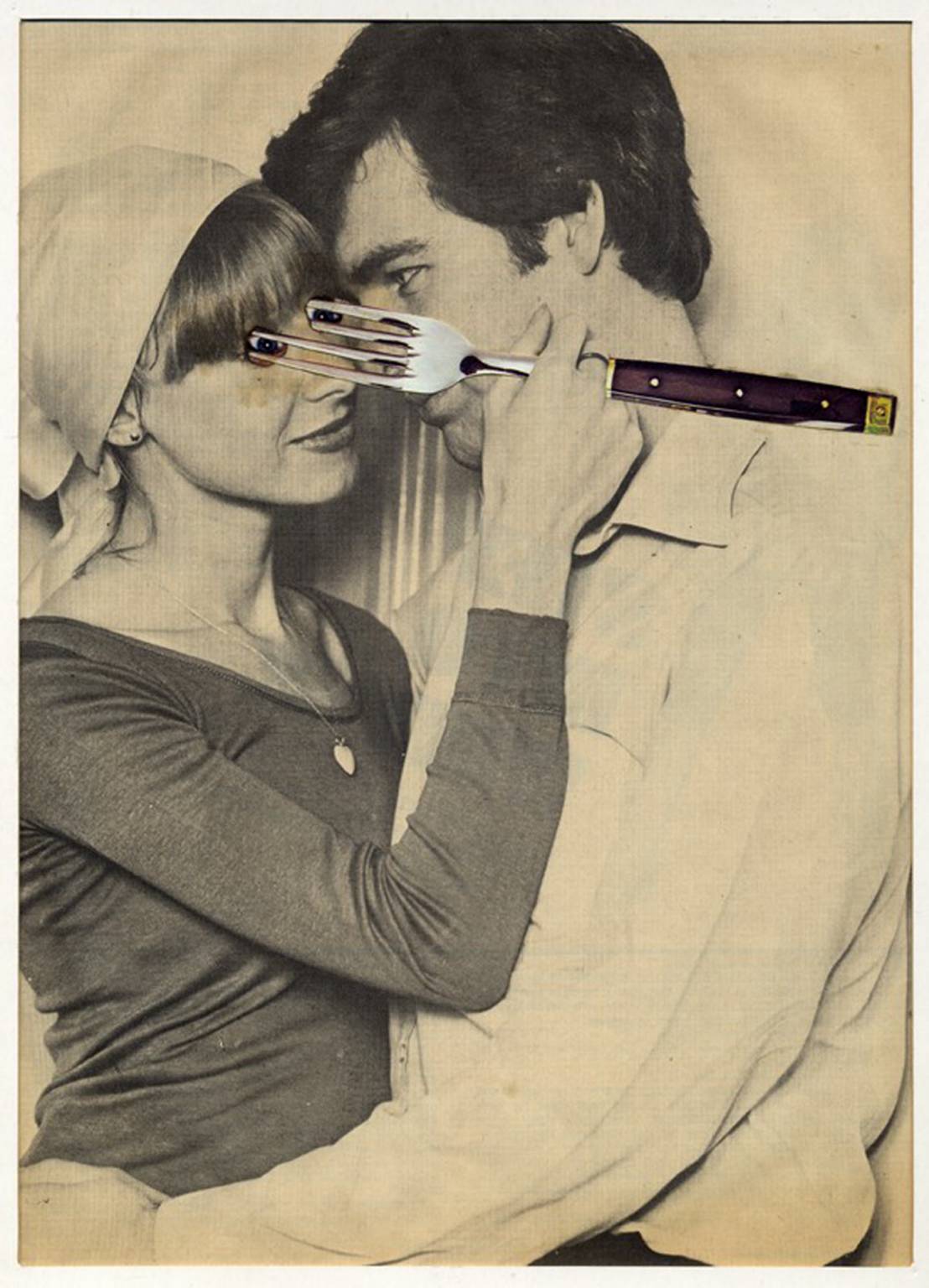
In this photomontage, the artist was making a statement about the Vietnam War and the contrast between the two realities: the horrors of war and the comfortable, blandness of everyday life in the US at that time. Rosler was referring to the fact that Americans carried on with their daily lives whilst the war raged on and would watch snippets of the ‘action’ on the news each night with a sense of disconnection – as though it was a movie – and influenced by media bias. I thought the use of drapes implied that the the viewer could close them once they had enough of seeing the scenes, but that did not mean it was not happening. The image also comments on the role of women in the household, i.e. making the house ‘look pretty’ no matter what.
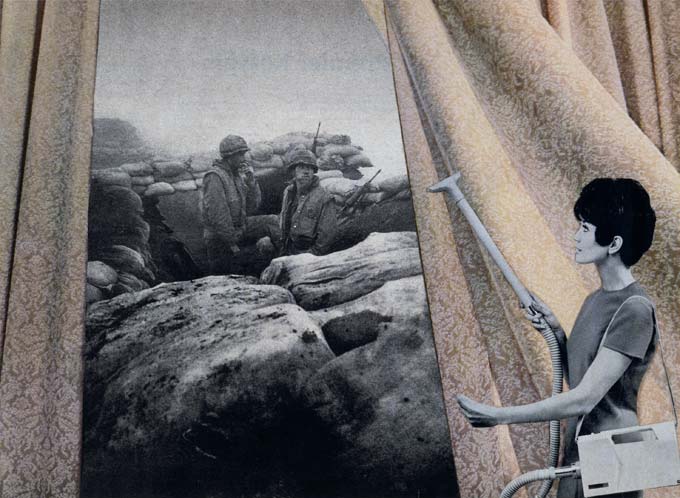
IDEA DEVELOPMENT
Next, I considered what subjects I might want to use for my photomontage:
- The representation of women in the media – this subject has been covered a great deal, but I thought I’d focus on the media (particularly newspapers) obsession with what females are wearing, which I find demeaning (e.g. what shoes the woman is wearing rather than details of what she is actually doing, which could be something inspiring for young girls).
- The constant bombardment of news snippets by the media, which I think has desensitised people. This idea strongly links to Martha Rosler’s work, above.
- The influence of the media on how news is reported and what is considered news – I find the bias and unpleasantness of some newspapers particularly distasteful.
- The destruction of Earth by the human race – climate change, wars, deforestation, pollution, factory farming, etc.
- The ‘comedy-horror show’ of the Trump presidency (in my opinion).
NOTE ON COPYRIGHT
I was unsure about copyright of images for use in collages/photomontages for educational use. I tried to find out more about this on the internet, but there was not any one clear statement whether it is OK to use photographs from newspapers or magazines for this purpose. It would be useful for there to be clear guidance on this matter, as it meant I could not pursue certain ideas (i.e. the one regarding the portrayal of women in the media) which would require the use of such images and would make for a more traditional photomontage feel. The sources I used for images were either free-to-use stock photo sites or via Google Image searches (with ‘Free to use, share and modify’ selected), which was the best way I could think of using images that would not infringe on any copyright laws. I also listed the sources at the bottom of the exercise.
I decided that the issue I wanted to focus on was the destruction of Earth by the human race, with particular focus on climate change. I have always taken a strong interest in environmental issues and thought this would be an excellent topic to explore using photomontage.
IDEA 1
For my first idea I did a very rough sketch. I found it difficult to do this for a montage, but it was quite useful for placement consideration.
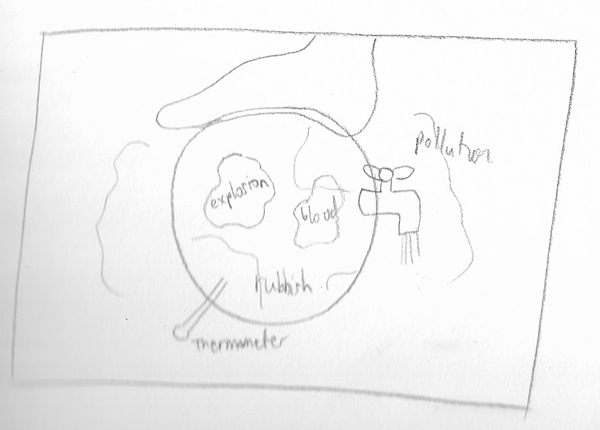
This idea was based on the showing various ‘problems’ human have created (or added to). The human influence is implied by the foot stepping on the planet and the other elements each represent an issue.
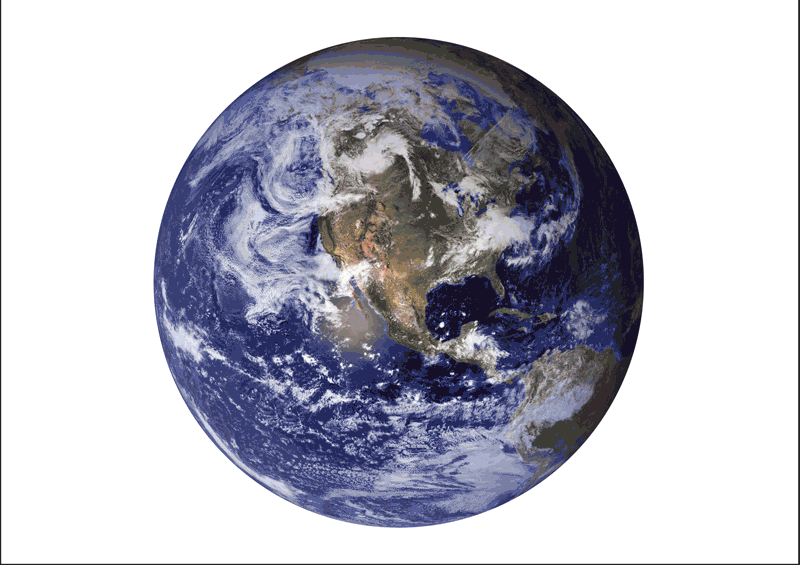
Explosion – represents wars/conflict.
Thermometer – represents global warming.
Tap with water – represents the relentless extraction of natural resources.
Rhino horn with blood stain – represents the plight of other species threatened by humans, e.g. by poaching.
Rubbish – represents the ever-increasing amount of waste being produced by a throw-away culture.
Pollution cloud – represents the poisonous gases being emitted by industry, cars, households, etc.
Blood splatter – represents the pain and suffering caused for all species on the planet by human behaviour
Human foot – represents the human race leaving an enormous footprint on the planet.
Squashed, red Earth – implies the pressure exerted by the human foot and the redness suggests heat as the planet continues to warm up.
The final image for my first idea can be seen below:
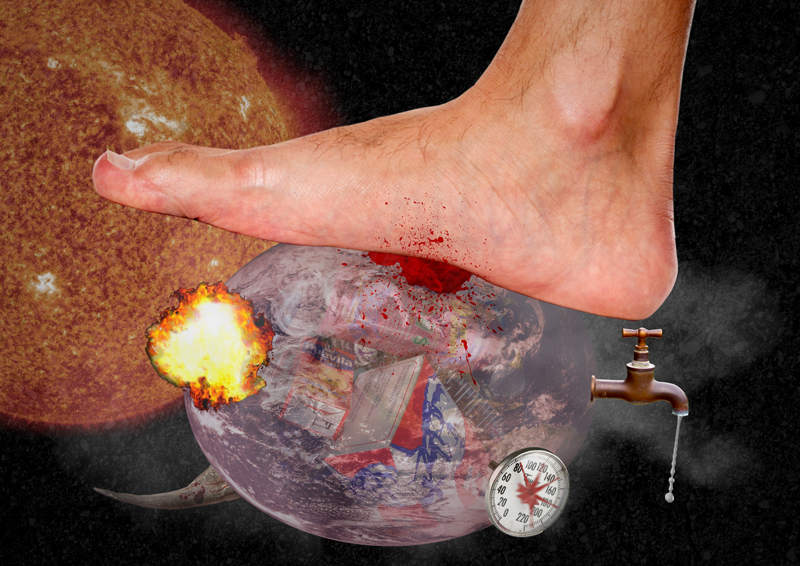
I thought this attempt was useful for learning about the selection tools and layering in Photoshop, but I was not that happy with the final result as the different elements do not blend well together visually. However, I did feel that the message of the piece was communicated quite clearly.
IDEA 2
Moving on, my next idea was based on the idea of humans consuming the Earth’s resources. I first thought of representing this by having the planet as the filling of a burger bun (replacing the patty) and setting this on a table, as I started to do below.
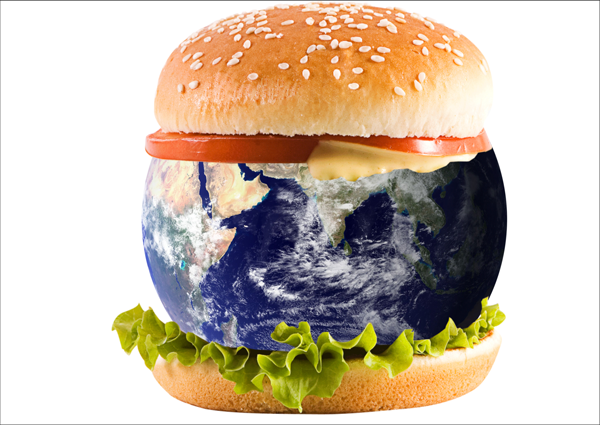
However, I wasn’t that keen on this and came up with an alternative idea, which started with a. sketch:
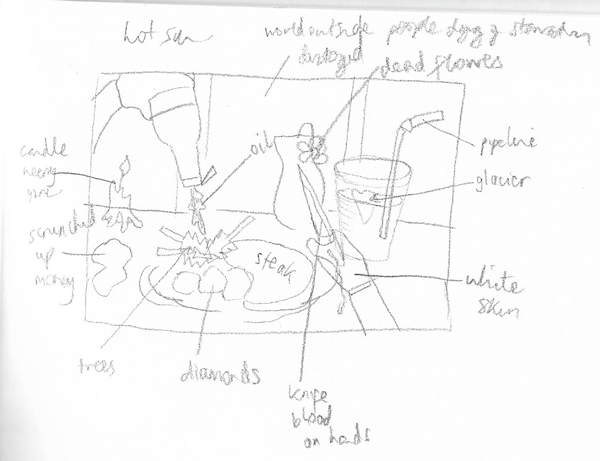
The initial idea was to use a plate of food as a metaphor for what the human race is ‘consuming’ from the planet and the resulting effects.
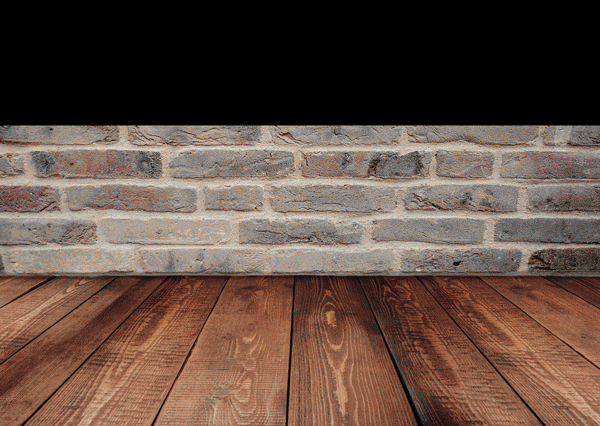
Steak: represents the fact that meat production is a main contributor of greenhouse gases, e.g. methane from animals and pollution from transport (besides the ethics of intensive factory farming).
Coal: represents the continued burning of fossil fuels.
Trees and logs: represents deforestation, e.g. for livestock, planting crops, developing (I found it sad to read that rainforests could be completely destroyed within 100 years).
Glass of water with floating iceberg: represents the melting of the glaciers due to increasing temperatures.
Knife with blood: represents the killing of other species and fellow humans.
Desert scene: represents the increasing desertification of land due to overuse by humans and warming global temperatures (I added an orange filter to the photo to add to the sense of heat).
Phone: represents the ever-increasing dependence on smartphones, which I think distances people from reality and they miss what is happening right in front of them (in the ‘real world).
Image of child in conflict (Yemen): I believe the constant access to mass media and the way in which news is reported causes people to become gradually desensitised to what they are seeing/hearing. The use of this image in this context demonstrates how what is truly horrendous can now be removed from someone’s view (and conscience) with the swipe of a finger.
Text on phone: this reinforces the point above, but it also could raise the question to the viewer of the image – do they want to ‘log off’ and ignore the issues be presented or ‘cancel’ and do something about it?
The final montage can be seen below.
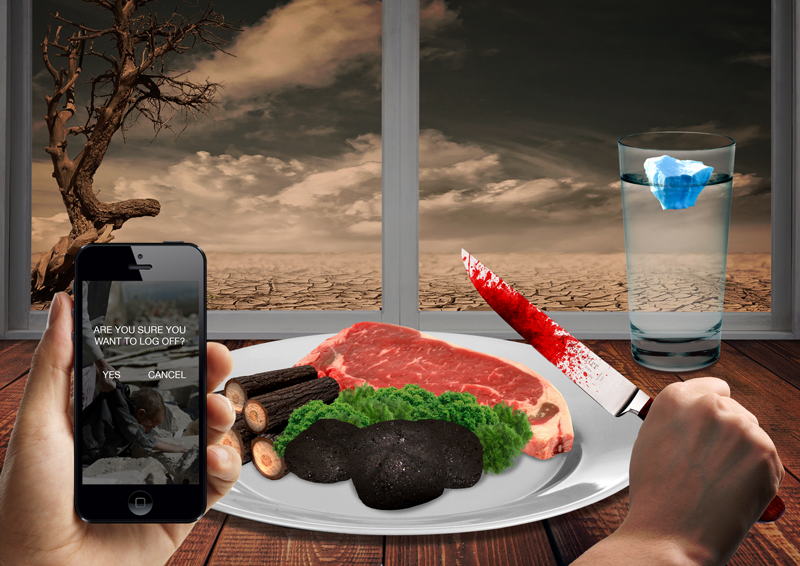
EVALUATION
I found this exercise to be challenging, but I particularly enjoyed researching different artists who have worked with photomontages/collages. I am becoming more interested in politically motivated themes, so this exercise was fascinating to me. I also liked the idea that images from different sources can be combined to make an entirely new meaning, with a message of purpose. It took me a while to come up with ideas of my own, but once I started to form thoughts for my final composition I become more confident. I am not that familiar with Photoshop, so this exercise was a perfect opportunity for learning new skills, such as selection tools and layers, which became easier as I progressed.
I was quite pleased with my final piece for this exercise. All of the images (apart from the one of the child in Yemen) were completely neutral in their original contexts, being mostly sourced from stock photo websites, but when placed together they became part of a narrative. I think the message of the piece is quite clearly communicated, but also requires the viewer to consider it for deeper meanings.
SOURCES-INITIAL RESEARCH
http://www.tate.org.uk/art/art-terms/m/montage
http://www.tate.org.uk/art/art-terms/p/photomontage
http://www.tate.org.uk/art/art-terms/c/collage
http://www.tate.org.uk/art/art-terms/d/dada
http://www.tate.org.uk/art/artworks/kennard-the-kissinger-mind-t12481
http://www.tate.org.uk/art/artists/peter-kennard-10184
http://www.tate.org.uk/art/artworks/kennard-haywain-with-cruise-missiles-t12484
http://www.tate.org.uk/art/artworks/hamilton-just-what-is-it-that-makes-todays-homes-so-different-p11358
http://www.tate.org.uk/art/artworks/hausmann-the-art-critic-t01918
http://www.tate.org.uk/art/artworks/schwitters-opened-by-customs-t00214
http://www.tate.org.uk/art/artworks/schwitters-picture-of-spatial-growths-picture-with-two-small-dogs-t03863
http://www.tate.org.uk/art/artworks/stezaker-mask-xiii-t12346
http://www.anothermag.com/art-photography/3318/top-10-collage-artists-hannah-hoch-to-man-ray
http://www.anothermag.com/art-photography/8849/three-radical-female-collage-artists-you-need-to-know
http://collections.vam.ac.uk/item/O128502/humanly-impossible-photograph-bayer-herbert/
http://collections.vam.ac.uk/item/O74462/pause-trink-coca-cola-poster-leupin-herbert/
http://collections.vam.ac.uk/item/O1102293/profil-en-face-photograph-bayer-herbert/
http://collections.vam.ac.uk/item/O191130/with-the-socialists-for-tomorrow-poster-farkas-bea-beatrix/
http://collections.vam.ac.uk/item/O128503/the-lonely-metropolitan-photograph-bayer-herbert/
http://collections.vam.ac.uk/item/O220382/haywain-with-cruise-missiles-photograph-kennard-peter-lawrence/
http://collections.vam.ac.uk/item/O93576/hands-act-photograph-bayer-herbert/
http://collections.vam.ac.uk/item/O100758/never-again-poster-gladwin-peter/
http://collections.vam.ac.uk/item/O1239969/photo-op-poster-kennard-peter/
http://collections.vam.ac.uk/item/O1135355/image-of-photomontage-illustration-from-photograph-cahun-claude/
http://collections.vam.ac.uk/item/O1135351/image-of-photomontage-illustration-from-photograph-cahun-claude/
http://collections.vam.ac.uk/item/O100770/defended-to-death-poster-gladwin-peter/
http://collections.vam.ac.uk/item/O116763/wahlt-koppler-und-das-ganze-poster-staeck-klaus/
http://collections.vam.ac.uk/item/O1193211/big-money-is-moving-in-poster-dunn-peter/
http://collections.vam.ac.uk/item/O116764/und-der-haifisch-der-hat-poster-staeck-klaus/
http://collections.vam.ac.uk/item/O1348469/die-neue-linie-cover-proof-proof-moholy-nagy-laszlo/
http://collections.vam.ac.uk/item/O1352674/photograph/
http://collections.vam.ac.uk/item/O233475/poster-engelmann-michael/
http://www.tate.org.uk/art/artists/linder-10844
http://www.tate.org.uk/art/artworks/linder-untitled-t12498
https://www.theguardian.com/artanddesign/2011/sep/02/linder-sterling-photomontage
http://collections.vam.ac.uk/item/O192045/23-august-1939-poster-broga-albertas/
http://collections.vam.ac.uk/item/O113058/crush-anti-union-laws-poster-sprague-ken/
https://www.telegraph.co.uk/business/2016/03/18/mc-saatchi-boosted-by-election-as-ad-giant-delivers-record-13m-p/
https://www.theguardian.com/artanddesign/2015/apr/03/the-10-best-british-political-posters
http://retroavangarda.com/john-heartfield-and-the-dawn-of-photomontage/
http://retroavangarda.com/dada-as-a-worldview/
https://www.moma.org/interactives/exhibitions/1997/sternbergbrothers/
http://www.tate.org.uk/art/artists/el-lissitzky-1519
https://www.bauhaus100.de/en/past/people/masters/marianne-brandt/
http://herbertmatter.org/welcome/biography
http://www.designhistory.org/Poster_pages/PhotoPoster.html
https://www.sbma.net/exhibitions/bayer
https://www.bauhaus100.de/en/past/works/graphics-typography/mit-allen-zehn-fingern/index.html
http://www.tate.org.uk/art/artworks/guerrilla-girls-do-women-have-to-be-naked-to-get-into-the-met-museum-p78793
https://www.theartstory.org/artist-rosler-martha.htm
https://www.theguardian.com/artanddesign/australia-culture-blog/2014/mar/27/john-stezaker-sydney-biennale
SOURCES-IDEAS
https://www.theguardian.com/environment/2016/mar/21/eat-less-meat-vegetarianism-dangerous-global-warming
https://www.theguardian.com/environment/2013/dec/20/tax-meat-cut-methane-emissions-scientists
https://climate.nasa.gov/causes/
https://www.nationalgeographic.com/environment/global-warming/deforestation/
https://helpsavenature.com/global-warming-melting-glaciers
https://climate.nasa.gov/climate_resources/4/graphic-dramatic-glacier-melt/
https://www.theguardian.com/environment/2010/dec/16/desertification-climate-change
https://www.bbc.co.uk/news/business-37468560https://www.news.com.au/technology/gadgets/mobile-phones/man-puts-his-body-on-the-line-to-prove-how-obsessed-we-are-with-our-phones/news-story/a16e201c0a111064db1b6ec930188ff2
https://www.encyclopedia.com/media/encyclopedias-almanacs-transcripts-and-maps/desensitization-and-media-effects
IMAGE SOURCES-IDEA 1
Planet Earth: http://tusb.stanford.edu/wp-content/uploads/2012/11/earth-from-space-western.jpg
Explosion: http://img07.deviantart.net/4689/i/2009/243/8/2/explosion__stock__by_enforcedcrowd.jpg
Foot: https://1.bp.blogspot.com/-nrct8qYTSus/VoEG-xTqC9I/AAAAAAAAQBE/1lbLHYuWkJM/s1600/Flat-Feet_03.jpg
Thermometer: https://c1.staticflickr.com/3/2459/3773209534_d15eb5b383_b.jpg
Blood 1: https://c1.staticflickr.com/3/2927/14231376315_535e69ede8_b.jpg
Blood 2: http://pngimg.com/uploads/blood/blood_PNG6116.png
Blood 3: http://pngimg.com/uploads/blood/blood_PNG6088.png
Tap: https://upload.wikimedia.org/wikipedia/commons/8/87/Brass_water_tap.jpg
Drip: https://upload.wikimedia.org/wikipedia/commons/e/e5/Dripping_faucet_2.jpg
Pollution cloud: http://pngimg.com/uploads/cloud/cloud_PNG8.png
Rhino: https://upload.wikimedia.org/wikipedia/commons/9/9e/Side_shot_of_white_rhino.jpeg
Sun: https://thusspokejon.files.wordpress.com/2013/01/plasma-blast.jpg
Rubbish: https://upload.wikimedia.org/wikipedia/commons/8/8b/Pile_of_trash_2.jpg
IMAGE SOURCES-IDEA 2
Planet Earth: http://tusb.stanford.edu/wp-content/uploads/2012/11/earth-from-space-western.jpg
Burger: http://pngimg.com/uploads/burger_sandwich/burger_sandwich_PNG4115.png
Plate: https://intermedio2englisheoi.wikispaces.com/file/view/plate.jpg
Steak: https://upload.wikimedia.org/wikipedia/commons/2/24/StripSteak.jpg
Tree: http://pngimg.com/uploads/tree/tree_PNG3477.png
Glass: http://pngimg.com/uploads/water_glass/water_glass_PNG15234.png
Iceberg: https://www.pexels.com/photo/iceberg-during-daytime-53389/
Knife: https://www.sabatier-k.com/client/gfx/photos/produit/375.jpg
Blood: http://pngimg.com/uploads/blood/blood_PNG6093.png
Coal: https://en.wikipedia.org/wiki/Briquette
Logs: https://www.turbosquid.com/3d-models/3d-model-wood-logs/626019
Table: https://www.pexels.com/photo/board-bricks-brickwork-concrete-269063/
Desert: https://www.pexels.com/photo/earth-desert-dry-hot-60013/
Fist: https://commons.wikimedia.org/wiki/File:Rock-paper-scissors_%28rock%29.png
Window: http://pngimg.com/download/17653
Hand holding phone: http://www.dmzaerial.com/wp-content/uploads/back-hand-phone1.png
Yemen war image: https://www.middleeastmonitor.com/20170327-un-100-civilians-killed-a-month-in-yemen-war-most-by-coalition/